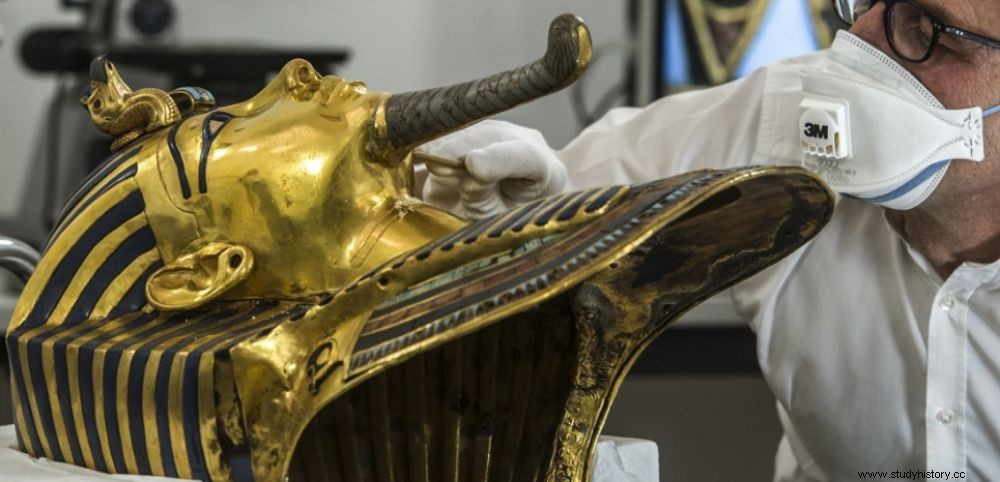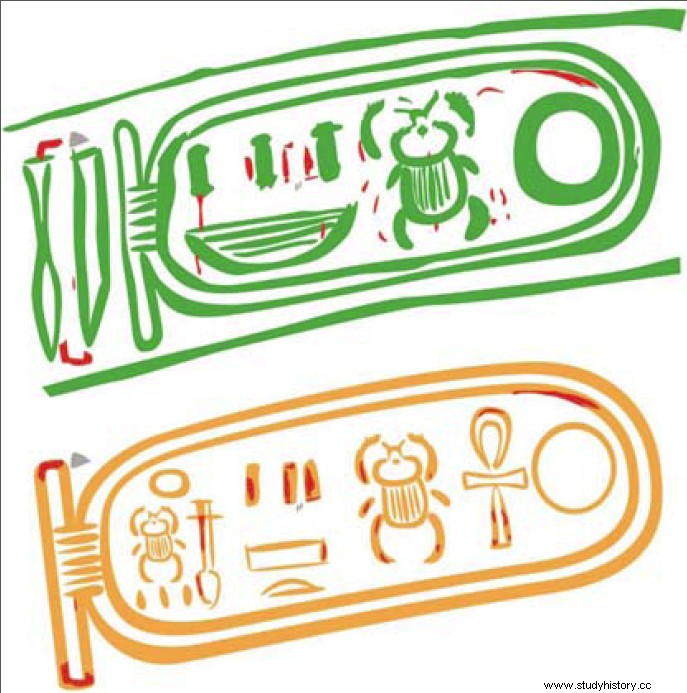 German restoration researchers work on the Golden Mask of Tutankhamun at the Cairo Museum in Egypt, on October 20, 2015.
German restoration researchers work on the Golden Mask of Tutankhamun at the Cairo Museum in Egypt, on October 20, 2015. REVELATIONS. It is an incredible series of announcements that archaeologist Nicholas Reeves has been submitting to us for three months. The British expert made stunning revelations about Tutankhamun after announcing the probable presence of unsuspected cavities in his tomb (to read in Sciences et Avenir n° 827, January 2016). According to him, the golden mask of the most famous pharaoh in the history of ancient Egypt has been usurped! Tutankhamun is said to have diverted the extraordinary golden mask for himself - found in his tomb (KV62) by Howard Carter in 1922 - when it was not intended for him! Supporting evidence.
In an article to be published* in December 2015 entitled "The golden mask of Ankhkheperure Neferneferuaton" - and excerpts of which were published on November 24 by the online daily Al-Arham Weekly - the British Egyptologist is engaged in a meticulous deciphering of the famous portrait in precious metal. Remember that this 11kg goldsmith masterpiece, made of an alloy of gold, silver and copper inlaid with quartz, obsidian and lapis lazuli, is an invaluable treasure that millions of tourists come to admire it every year in the Cairo Museum where it is kept. Nicolas Reeeves thus resumes, by validating it, a hypothesis, which he had put forward several years ago when he worked in the department of Egyptian antiquities at the British Museum (London), according to which the mask would have been fashioned not for the young King Tutankhamen , who died at the age of 19, but for one of his predecessors, the mysterious Ankhkheperure Neferneruaton whom the British archaeologist identifies as… Nefertiti.
Erased traces of a previous name
It was thanks to the recent restoration work carried out on the famous mask following a sad story of a badly glued beard that Nicholas Reeves was able to verify what until then had only been a hypothesis. Because the meticulous examination of the cartouche* of Tutankhamen engraved on the gold clearly shows the erased traces of a previous royal name! In collaboration with the former director of the Cairo Museum, Mahmoud Al-Halwagi, and the photographer Ahmed Amin, "it was possible to obtain an exceptionally precise image of this palimpsest" , explains the French Egyptologist Marc Gabolde*, lecturer at the Paul-Valéry University of Montpellier III, who collaborated on the analysis with Ray Johnson, from the Oriental Institute of the University of Chicago. "The original cartouche engraved on the gold mask has been clearly transformed , (see drawings below), continues the expert. A first name has been 'burnished' (polite, Editor's note) with a tool which made it possible to erase the traces, and the name of Tutankhamun was engraved on top" . The golden mask was simply adapted to the young pharaoh of the 18 e dynasty at the time of his death.

The modifications to which Tutankhamun's cartouche was subjected are shown in this illustration by Marc Gabolde. In green, the current cartouche of Tutankhamun; in orange, the reconstructed original cartouche; in red, the still visible traces of the erased name. © Marc Gabolde
DOUBT. In the community of Egyptologists, these doubts existed for several years and were even shared by Howard Carter, the discoverer of the famous tomb. "We already had the example of small sarcophagi with golden viscera as well as a pectoral, which I had noticed did not belong to this sovereign. In reality, we are fast approaching the fact that virtually all of Tutankhamun's grave goods were not intended for him!" , continues Marc Gabolde, author of a recent book on the most famous of the pharaohs (Tutankhamun , Pygmalion editions, 2015). It is therefore all the precious funerary furniture that Tutankhamun would have usurped! The archaeologist, however, wants to be indulgent with the indelicate young sovereign. "It should not be forgotten that the ten years that this young king spent in power were rich in architectural, textual and artistic productions, too often eclipsed by the wonders and mysteries of his tomb" .
Cartridge
In ancient Egypt, a cartouche (shenou ) is an oval-shaped hieroglyphic symbol, closed by a knot, which contains the name and title of the pharaoh. The identification of royal cartouches was one of the essential elements in the process of deciphering Egyptian hieroglyphs by Jean-François Champollion (1790-1832).
